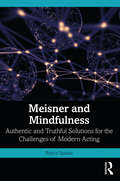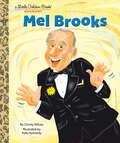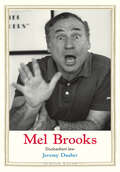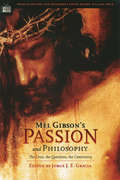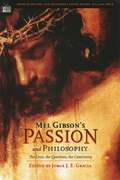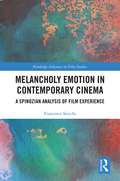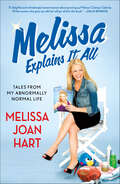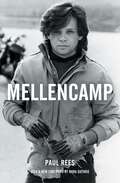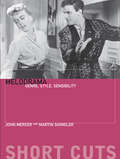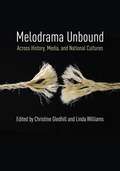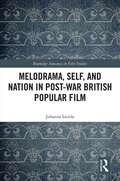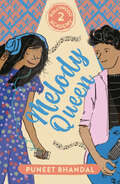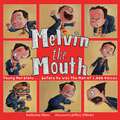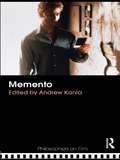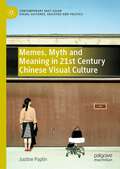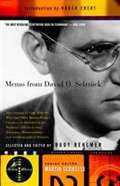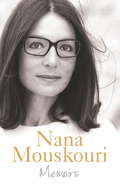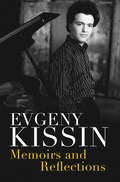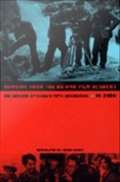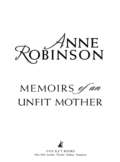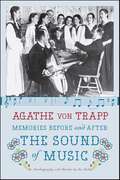- Table View
- List View
Megan Owlet
by Beth Anne MarescaMegan Owlet doesn’t want to play basketball, learn karate, or practice the violin. Every day she goes and cheers her brothers on as they participate in their own activities, but one morning she wakes up and realizes she’s bored! It’s time for Megan to find something of her own to do. After an unsuccessful brainstorming session with her animal friends, Megan stumbles upon a dance studio, and with an excited screech she begins to dream big dreams of whirls and twirls. Dancing is trickier than Megan expected, but with a little help from her brothers, Megan can do anything! From debut author and illustrator Beth Anne Maresca, Megan Owlet teaches children to pursue their own dreams and to be brave in making them happen. This is a story about love, support, and family, and parents and children alike will be enchanted by its heartwarming ending and beautiful watercolor illustrations.
Meisner and Mindfulness: Authentic and Truthful Solutions for the Challenges of Modern Acting
by Royce SparksMeisner and Mindfulness: Authentic and Truthful Solutions for the Challenges of Modern Acting is the first book that reveals how Meisner and mindfulness can be united to create strong results for actors and help them navigate the challenges of the digital age. The twenty-first century has created an entirely new set of demands and pressures on the working actor, including an acceleration of the digital age and the complications of COVID-19, which have led to auditions, rehearsals, and even whole performances happening entirely in isolation. This book combines a modern rethinking of the Meisner technique with a complementary set of tools from mindfulness meditation to offer profound solutions to these growing challenges, addressing the demands of a post-coronavirus industry as well as the pressures of acting in the digital era. In this ground-breaking expansion of the technique, readers will discover how it is possible to train some of the deepest values of living truthfully under a given set of circumstances, both with other actors and whilst alone. Since the 1950s the Meisner technique has aided the actor in navigating the demands unique to their time. This book is a powerful reminder that, even in the midst of so many changes and challenges, the truthfulness that has defined outstanding performances across generations is still within reach. Full of easily accessible mindfulness and Meisner exercises and principles for practice-based support, Meisner and Mindfulness will be illuminating to working actors, directors, students and instructors of acting, and practitioners of the Meisner technique looking to develop the authenticity, immediateness, and closeness essential to great acting. The book also includes access to an online supplement featuring additional exercises and concepts, including new ways to incorporate Meisner exercises into training sessions, suggestions for how Meisner-oriented companies can use exercises such as repetition in rehearsals, and discussions for how to set up a facilitated Meisner group.
Mel Brooks: A Little Golden Book Biography (Little Golden Book)
by Christy MihalyHelp your little one dream big with a Little Golden Book biography about comedian, actor, and filmmaker Mel Brooks. Little Golden Book biographies are the perfect introduction to nonfiction for young readers—as well as fans of all ages!This Little Golden Book about Mel Brooks--legendary EGOT funnyman and director of classics such as Young Frankenstein and The Producers--is an inspiring read-aloud for young children and their parents and grandparents who are fans.Look for more Little Golden Book biographies: • Betty White • Carol Burnett • Lucille Ball • Harry Belafonte • Julie Andrews • Dwayne Johnson
Mel Brooks: Disobedient Jew (Jewish Lives)
by Jeremy DauberA spirited dive into the life and career of a performer, writer, and director who dominated twentieth-century American comedy Mel Brooks, born Melvin Kaminsky in Brooklyn in 1926, is one of the great comic voices of the twentieth century. Having won almost every entertainment award there is, Brooks has straddled the line between outsider and insider, obedient and rebellious, throughout his career, making out-of-bounds comedy the American mainstream. Jeremy Dauber argues that throughout Brooks&’s extensive body of work—from Your Show of Shows to Blazing Saddles to Young Frankenstein to Spaceballs—the comedian has seen the most success when he found a balance between his unflagging, subversive, manic energy and the constraints imposed by comedic partners, the Hollywood system, and American cultural mores. Dauber also explores how Brooks&’s American Jewish humor went from being solely for niche audiences to an essential part of the American mainstream, paving the way for generations of Jewish (and other) comedians to come.
Mel Gibson's Passion and Philosophy
by William Irwin Jorge J. GraciaMel Gibson's The Passion of the Christ has become one of the most controversial films ever made, and it is already a blockbuster of cinematography. Its defenders passionately regard it as one of the most moving and influential pieces of religious art ever created. But its detractors argue with comparable vehemence that the violence and gore it contains, its alleged anti-Semitism, a particular take on the Christian message, and the lack of historical and Biblical accuracy, make it nothing more than a kind of political propaganda. Father Thomas Rosica hailed as one of the great masterpieces of religious art, but the secular humanist Paul Kurtz thinks of it as a political weapon in the hands of the religious right. Film critics are divided in their judgment, giving the film anywhere from no stars to five stars. Regardless of what one thinks of the film, however, its impact both personal and social is beyond question.
Mel Gibson's Passion and Philosophy: The Cross, the Questions, the Controversy
by Jorge J. E. GraciaIn Mel Gibson's Passion and Philosophy (Volume 10 in the series, Popular Culture and Philosophy), twenty philosophers with widely varying religious and philosophical backgrounds examine all the most important issues raised by the movie (The Passion of the Christ, Mel Gibson's spectacular film about the death of Jesus), without ridicule or rancor.
Melancholy Emotion in Contemporary Cinema: A Spinozian Analysis of Film Experience (Routledge Advances in Film Studies)
by Francesco SticchiThis work outlines a new methodology for film analysis based on the radical materialist thought of Baruch Spinoza, re-evaluating contemporary cognitive media theory and philosophical theories on the emotional and intellectual aspects of film experience. Sticchi’s exploration of Spinozian philosophy creates an experiential constructive model to blend the affective and intellectual aspects of cognition, and to combine it with different philosophical interpretations of film theory. Spinoza’s embodied philosophy rejected logical and ethical dualisms, and established a perfect parallelism between sensation and reason and provides the opportunity to address negative emotions and sad passions without referring exclusively to traditional notions such as catharsis or sublimation, and to put forth a practical/embodied notion of Film-Philosophy. This new analytical approach is tested on four case studies, films that challenge the viewer’s emotional engagement since they display situations of cosmic failure and depict controversial and damaged characters: A Serious Man (2009); Melancholia (2011); The Act of Killing (2012) and Only Lovers Left Alive (2013). This book is an important addition to the literature in Film Studies, particularly in Cognitive Film Theory and Philosophy of Film. Its affective and semantic analyses of film experience (studies of embodied conceptualisation), connecting Spinoza’s thought to the analysis of audiovisual media, will also be of interest to Philosophy scholars and in academic courses of film theory, film-philosophy and cognitive film studies.
Melissa Etheridge
by Chris NicksonChris Nickson's biography of Melissa Etheridge explores the pop star's life and music. Born in Leavenworth, Kansas, Melissa Etheridge faced years of struggle and hard work to make it in the music business. But through it all, she's remained determined, and now has multiple platinum records and Grammys to her name and an original sound that's all her own. Nickson tells the whole story in this biography fans are sure to enjoy.
Melissa Explains It All: Tales from My Abnormally Normal Life
by Melissa Joan HartMelissa Joan Hart explained it all-from dating to bullies-in her groundbreaking role as Clarissa Darling on Clarissa Explains It All. She cast a spell on millions more viewers as Sabrina, the Teenage Witch. Now, in Melissa Explains It All, Melissa tells the frank and funny behind-the-scenes stories from her extraordinary past and her refreshingly normal present.Melissa has been entertaining audiences most of her life; when there were no girls named Melissa on her favorite show, the forceful four year old decided she'd get on television her way. From that moment on, Melissa has shown a singular determination and focus-whether it's for booking three national commercials so her dad would build her a tree house or for nailing the audition for Clarissa. From her first commercial to her current starring role in ABC Family's hit Melissa andJoey, Hart never let fame go to her head. She always had one foot in Hollywood and one foot in reality-and still does. Melissa makes us laugh along with her as she talks about:--guest appearances in shows like Saturday Night Live and The Equalizer--auditioning for Punky Brewster and Clarissa--her early Broadway days--wacky parties she's thrown and attended-- the actors who influenced her and whom she befriended, worked with and competed against --her experiences both on and off-set-with Sabrina's Salem the Cat and Elvis the Alligator on Clarissa--how she met the love of her life at the Kentucky Derby Melissa Joan Hart explains all that she's learned along the way-what's kept her grounded, normal and working when others have not been so fortunate-and that she's the approachable, hilarious girl-next-door her fans have always thought she'd be.
Mellencamp
by Paul ReesThe definitive biography of John Mellencamp, the iconic American rock and roll original, featuring exclusive in-depth interviews and never-before-told details. Perfect for fans of Janis and Born to Run.John Mellencamp is not your typical rock star. With music inspired by the work of William Faulkner, John Steinbeck, and other giants of American literature, he has experienced a colorful career unlike any other. Now, this fascinating biography fully charts the life of one of this country&’s most important voices in American music. Mellencamp&’s story is also the story of the American heartland. His coming of age as an artist and evolution into legendary status directly reflected the major changes of the last fifty years. From the Summer of Love to the growing divisiveness of American politics and beyond, his music has served as the backdrop to this evolving country for millions of fans. Featuring exclusive interviews with friends, family, and colleagues, and exploring everything from the founding of Farm Aid to his induction into the Rock and Roll Hall of Fame, this is a fresh and expansive look at a true original.
Melodrama
by Martin Shingler John MercerMelodrama: Genre, Style and Sensibility is designed as an accessible overview of one of the most popular genres at undergraduate Film Studies. The book identifies three distinct but connected concepts through which it is possible to make sense of melodrama; either as a genre, originating in European theatre of the 18th and 19th century, as a specific cinematic style, epitomised by the work of Douglas Sirk or as a sensibility that emerges in the context of specific texts, speaking to and reflecting the desires, concerns and anxieties of audiences. Films discussed include All That Heaven Allows, Safe, Fear Eats the Soul, Black Narcissus, Suddenly Last Summer and Rebel Without a Cause. Each chapter includes overviews of key essays, analyses of significant and widely studied films and includes an annotated reading list.
Melodrama Unbound: Across History, Media, and National Cultures (Film and Culture Series)
by Linda Williams Christine GledhillFor too long melodrama has been associated with outdated and morally simplistic stereotypes of the Victorian stage; for too long film studies has construed it as a singular domestic genre of familial and emotional crises, either subversively excessive or narrowly focused on the dilemmas of women. Drawing on new scholarship in transnational theatrical, film, and cultural histories, this collection demonstrates that melodrama is a transgeneric mode that has long spoken to fundamental aspects of modern life and feeling.Pointing to melodrama’s roots in the ancient Greek combination of melos and drama, and to medieval Christian iconography focused on the pathos of Christ as suffering human body, the volume highlights the importance to modernity of melodrama as a mode of emotional dramaturgy, the social and aesthetic conditions for which emerged long before the French Revolution. Contributors articulate new ways of thinking about melodrama that underscore its pervasiveness across national cultures and in a variety of genres. They examine how melodrama has traveled to and been transformed in India, China, Japan, and South America, whether through colonial circuits or later, globalization; how melodrama mixes with other modes such as romance, comedy, and realism; and finally how melodrama has modernized the dramatic functions of gender, class, and race by orchestrating vital aesthetic and emotional experiences for diverse audiences.
Melodrama, Self and Nation in Post-War British Popular Film (Routledge Advances in Film Studies)
by Johanna LaitilaThis book investigates the portrayal of nationalities and sexualities in British post-Second World War crime film and melodrama. By focussing on these genres, and looking at the concept of melodrama as an analytical tool apt for the analysis of both sexuality and nation, the book offers insight into the desires, fears, and anxieties of post-war culture. The problem of returning to ‘normalcy’ after the war is one of the recurring themes discussed; alienation from society, family, and the self were central issues for both women and men in the post-war years, and the book examines the anxieties surrounding these social changes in the films of the period. In particular, it explores heterosexuality and nationality as some of the most prominent frameworks for the construction of identities in our time, structures that, for all their centrality, are made invisible in our culture.
Melodrama: Genre, Style and Sensibility (Short Cuts)
by Martin Shingler John MercerMelodrama: Genre, Style and Sensibility is designed as an accessible overview of one of the most popular genres at undergraduate Film Studies. The book identifies three distinct but connected concepts through which it is possible to make sense of melodrama; either as a genre, originating in European theatre of the 18th and 19th century, as a specific cinematic style, epitomised by the work of Douglas Sirk or as a sensibility that emerges in the context of specific texts, speaking to and reflecting the desires, concerns and anxieties of audiences. Films discussed include All That Heaven Allows, Safe, Fear Eats the Soul, Black Narcissus, Suddenly Last Summer and Rebel Without a Cause. Each chapter includes overviews of key essays, analyses of significant and widely studied films and includes an annotated reading list.
Melody Queen: Melody Queen (The Bollywood Academy #2)
by Puneet BhandalCan music-obsessed Simi stand up to a gender-biased industry? Twelve-year-old Simi's life is set. First: graduate from the Bollywood Academy, school to future stars. Second: become a super-famous actor, just like her showbiz parents. There's only one problem: Simi would rather make music than act, and music is a profession dominated by men. Can Simi navigate the gender barriers of the industry to prove she has what it takes to become Bollywood's next big music composer? A story of passion for music and courage in the face of overwhelming odds, this second book in the dazzling world of Bollywood is sure to get your toes tapping and head bopping to Simi's beat.
Melvin the Mouth
by Katherine BlancMeet young Melvin—the future Mel Blanc of Looney Tunes fame—as he drives everyone a little nuts with the noisy soundtrack to his day-to-day life Melvin is an imaginative and noisy little boy who grows up to be Mel Blanc, Looney Tunes cartoon character pioneer and the voice behind Bugs Bunny, Daffy Duck, Woody Woodpecker, the Tasmanian Devil, and so many more familiar personalities. Readers are treated to a typical day for young Melvin, when ordinary tasks like getting ready for school, riding the bus, and completing his chores are charged with sound effects and accompanied by his own personal soundtrack. His knack for making funny noises and using the versatility of his voice was like no other—much to the relief of his teachers. Penned by Blanc's daughter-in-law, this first-person fiction-based-in-reality story is a fun romp and is sure to inspire young readers to turn trouble into triumph! &“Reading this book aloud will guarantee a boisterous romp of a story time in a library or classroom setting.&” —School Library Journal
Memento (Philosophers on Film)
by Andrew KaniaWithin a short space of time, the film Memento has already been hailed as a modern classic. Memorably narrated in reverse, from the perspective of Leonard Shelby, the film’s central character, it follows Leonard’s chaotic and visceral quest to discover the identity of his wife’s killer and avenge her murder, despite his inability to form new long-term memories. This is the first book to explore and address the myriad philosophical questions raised by the film, concerning personal identity, free will, memory, knowledge, and action. It also explores problems in aesthetics raised by the film through its narrative structure, ontology, and genre. Beginning with a helpful introduction that places the film in context and maps out its complex structure, specially commissioned chapters examine the following topics: memory, emotion, and self-consciousness agency, free will, and responsibility personal identity narrative and popular cinema the film genre of neo-noir Memento and multimedia Including annotated further reading at the end of each chapter, Memento is essential reading for students interested in philosophy and film studies.
Memes, Myth and Meaning in 21st Century Chinese Visual Culture (Contemporary East Asian Visual Cultures, Societies and Politics)
by Justine PoplinThis book explores the impact of global change in China in what is considered in the West as ‘the Asian century’ and what this in turn means for visual culture. Unravelling a deep understanding of historical shifts in visual culture that represent socio-political mirrors of culture, it expands the Western perception of Chinese visual culture and the intertwined complexities of cultural signification. This book provides a key resource for Galleries and Academic Institutions, offering insights into understanding the systems underpinning ideas, skills and influences of the new visual culture in the Asian century.
Memo From David O. Selznick: The Creation of "Gone with the Wind" and Other Motion Picture Classics, as Revealed in the Producer's Private Letters, Telegrams, Memorandums, and Autobiographical Remarks (Modern Library Movies)
by Martin Scorsese Roger Ebert David Selznick Rudy BehlmerDavid O. Selznick was a unique figure in the golden Hollywood studio era. He produced some of the greatest and most memorable American films ever made--notably, Rebecca, A Star Is Born, Anna Karenina, A Farewell to Arms, and, above all, Gone With the Wind. Selznick's absolute power and artistic control are evidenced in his impassioned, eloquent, witty, and sometimes rageful memos to directors, writers, stars and studio executives, writings that have become almost as famous as his films. Newsweek wrote,"I can't imagine how a book on the American movie business could be more illuminating, more riveting or more fun to read than this collection of David Selznick's memos.
Memoirs
by Nana MouskouriNana Mouskouri, the Greek singer and one of the world's most popular entertainers, tells her life story for the first time.For more than 40 years Nana Mouskouri has been a global singing sensation, from her earliest childhood memories of mid-Thirties Greece to her unstoppable rise to the summit of her profession. She tells of life as a child, experiencing the horrors of war and privation, victimised by bitter parental discord, stigmatised by her father's fatal addiction to gambling.She was a shy inhibited teenager with a passion for singing, a girl compelled to choose between her love of classical music and her fascination with popular song. As a highly successful adult, she has been racked by uncertainty and the torments of love, a woman struggling to balance music - her raison d'etre - with her role as wife and mother.Here she describes the life of the star we all know, from her beginnings in the nightclubs of Athens to her triumphs on the world's most glittering stages. Nana launches us into her international tours, taking us to Canada, the United States, Japan and Australasia as well as every country in Europe. She describes how she fought to win over audiences everywhere. In Britain, for example, she enjoyed dazzling success after her first English album Over and Over was released. In quick succession, twenty-three of her titles appeared in the charts. In Australia, she achieved fourteen gold discs in 1974 alone.Hers is a rich and astonishing life, studded with exceptional encounters and friendships: the incomparable trumpeter Quincy Jones, a musician Nana had secretely worshipped since childhood, introduced her to the United States and became her producer; Yvonne Littlewood, the BBC producer, made Nana a leading star of British television in the 1960s and remains one of her closest friends. Queen Elizabeth II, Bob Dylan, Frank Sinatra, and the Empress Farah Diba of Iran are among the galaxy of extraordinary figures who played a vital part in Nana's career. Intimate, rich in humanity and music, a spotlit global tour, Nana's book is an event.
Memoirs and Reflections
by Evgeny KissinEvgeny Kissin's musicality, the depth and poetic quality of his interpretations, and his extraordinary virtuosity have earned him the veneration and admiration deserved only by one of the most gifted classical pianists of his generation. He is internationally renowned and hugely admired for his interpretations of the works of the classical and Romantic repertoire of Beethoven, Schubert, Chopin, Liszt, Schumann, Brahms, Rachmaninov and Prokofiev. He is in demand the world over, and has appeared with many of the world's great conductors, as well as all the great orchestras of the world. In Memoirs and Reflections, the intensity of Kissin's thinking and of his very being shines through, which displays his astonishing memory, fondness for his family and teachers, and an exalted sense of self that is essentially Russian.
Memoirs and Reflections
by Evgeny KissinEvgeny Kissin's musicality, the depth and poetic quality of his interpretations, and his extraordinary virtuosity have earned him the veneration and admiration deserved only by one of the most gifted classical pianists of his generation. He is internationally renowned and hugely admired for his interpretations of the works of the classical and Romantic repertoire of Beethoven, Schubert, Chopin, Liszt, Schumann, Brahms, Rachmaninov and Prokofiev. He is in demand the world over, and has appeared with many of the world's great conductors, as well as all the great orchestras of the world. In Memoirs and Reflections, the intensity of Kissin's thinking and of his very being shines through, which displays his astonishing memory, fondness for his family and teachers, and an exalted sense of self that is essentially Russian.
Memoirs from the Beijing Film Academy: The Genesis of China's Fifth Generation
by Ni ZhenAfter graduating from the Beijing Film Academy in 1982, directors like Chen Kaige and Zhang Yimou transformed Chinese cinema with Farewell My Concubine, Yellow Earth, Raise the Red Lantern, and other international successes. Memoirs from the Beijing Film Academy tells the riveting story of this class of 1982, China's famous "Fifth Generation" of filmmakers. It is the first insider's account of this renowned cohort to appear in English. Covering these directors' formative experiences during China's tumultuous Cultural Revolution and later at the Beijing Film Academy, Ni Zhen--who was both their screenwriter and teacher--provides unique insights into the origins of the Fifth Generation's creativity. Drawing on his personal knowledge and interviews conducted especially for this volume, Ni Zhen demonstrates the diversity of the Fifth Generation. He comments on the breadth of styles and themes explored by its members and introduces a range of male and female directors, cinematographers, and production designers famous in China but less well-known internationally. The book contains vivid descriptions of the production processes of two pioneering films--One and Eight and Yellow Earth.
Memoirs of an Unfit Mother
by Anne RobinsonWho is Anne Robinson?She's the notorious grand inquisitor of the television sensation The Weakest Link. She's the first woman in nearly half a century to host a prime-time game show. She's the highest-paid female journalist in British history. She warrants fan mail and death threats, fear and loathing, unqualified admiration and unabashed hatred. . . . But what you don't know about the Host from Hell could fill a book. From pioneering journalist to overnight pop-culture phenomenon, Anne Robinson tells all with the same bar-nothing candor that won her the honor of "rudest woman on TV" (Britain's TVTimes). But now Anne Robinson trains her steely-eyed focus on her own past. With unblinking honesty she shares the events of her formative upbringing by a sensitive father and a driven, hardworking mother who was "part magic, part monster. " With unreserved pride she reveals the headline-making battles to carve out her own career as a journalist, a controversial consumer reporter, and a BBC anchor -- a calling that took its toll on a troubled marriage and a sensational, highly publicized custody battle. And with biting humor, Anne Robinson explores what brought her to her latest level of infamy: the autocratic style, withering glance, and stinging lash of the lady in black, landing her in the unique position of being both the most popular and unpopular television personality in history. This is Anne Robinson. Are you game?
Memories Before and After the Sound of Music: An Autobiography
by Agathe von TrappAgathe von Trapp, the oldest daughter in the Trapp Family Singers, offers readers the real story behind an American classic in her poignant and fascinating autobiography Memories Before and After The Sound of Music. The courageous family and events immortalized in the beloved Broadway musical and hit Hollywood film come vibrantly alive in these pages, and Agathe’s post-Sound of Music life is equally compelling.

